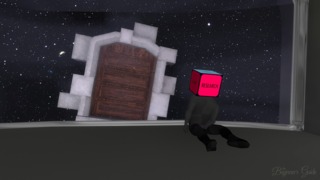
I don’t think I’ve ever been as careful in writing about a game as I am now, writing about Davey Wreden’s The Beginner’s Guide. I’m not watching my step for fear of spoilers, nor am I worried about rocking the boat with my "hot take." Instead, I’m being careful because Wreden’s latest has made me seriously consider the tricky relationship between game maker and player, between artist and audience.
The Beginner’s Guide is the pseudo-followup to 2013’s The Stanley Parable, which was written by Wreden. I say “pseudo-followup” not only because The Stanley Parable’s level designer, William Pugh, is not involved in this new project, but also because there is a clear difference in tone and focus between the games, even though they're both first person narrative adventures. While The Stanley Parable cleverly preyed on player assumptions about games, geometry, morality, and story structure, The Beginner’s Guide zooms out a bit, exploring how even clean, digital creations are mediated through our confusing, analog psyches.
Moments into The Beginner’s Guide, Wreden smashes down the fourth wall. His voice addresses you directly as you walk around what looks like a restrictive version of Counter-Strike’s most popular map, de_dust2. Wreden explains that over the next hour and a half or so, he’s going to lead you through a bunch of Source Engine maps, unfinished prototypes, and experimental games developed by his friend Coda--who is probably (maybe?) fictional. His stated purpose for doing this is two-fold: First, he wants to share these underappreciated gems of design with you. Second, he wants to show that careful analysis of a game designer’s work can reveal volumes about their internal working. He wants to unpack who Coda is for us through his games.
Wreden takes us through Coda's game chronologically, from the late 2000s and early 2010s, a period of growth for an emerging independent scene. Wreden’s original Stanley Parable mod was released in 2011, and Coda’s portfolio is filled with the sorts of experiments you could imagine him doing in that era. Though these levels are sometimes mundane (claustrophobic hallways, charming living rooms, a handful of prison cells), they're also short meditations on geometry and crafty mechanical demonstrations. My favorite are those buggy and unfinished sketches of overly-ambitious projects, where you can practically see Coda becoming distracted by some new, small idea. You walk through these levels, occasionally stopping to solve some light puzzles or perform some small task. Now and then you get to make some dialog choices inside of Coda's games, but the majority of your time is spent just listening to Wreden lecture.
The Beginner's Guide is a game with tides. At first it flows in close to you, warm and enveloping, as Wreden offers insightful analysis of Coda’s games while simultaneously demonstrating his own emotional investment. The way that he carefully (and joyfully) shares the secrets behind Coda’s levels calls to mind Robert Yang’s fantastic PRACTICE 2013 talk, which dug deep into the guts of Half-Life's code. Wreden’s intimate knowledge of Coda's games is similarly exhaustive and effusive, but that’s the point where the Beginner’s Guide ebbs away, and Wreden’s personal investment in Coda’s games shifts in color.

The whole project of excavating and displaying Coda's games begins to feel illicit. The voice acting gets a little hamfisted, and the way that Wreden and Coda’s relationship plays out is a bit too on-the-nose, but I can’t deny how effective it is on the whole. The Beginner’s Guide feels autobiographical, but I can’t quite place how autobiographical it is (if at all). It's hard to know where the Wreden the (real life) designer, Wreden the (in-game) narrator, and Coda end and begin. Though I was fairly confident throughout my playthrough that the Wreden (the designer) invented Coda and built all of his games for the purposes of The Beginner's Guide, when I reached the end credits I found myself with the sinking feeling that I'd wandered into a private conflict that I had no right to see. Without being too direct, let me say that if I knew that the most potent and personal story elements of The Beginner's Guide were true, I don't think I would've written about it all.
As the game continues, questions emerge--and not just questions about the relationship between Wreden and Coda. The Beginner’s Guide asks us about the responsibilities a game designer and a player have to each other. It asks what desires are being met by the games we play, and it demands that we consider how we think about the developers behind them. I find myself wondering why I've been referring to this as "Wreden's" game, even though I know that others worked on the project with him. More broadly, The Beginner's Guide has made me question whether I feel like game designers owe me something. Like the games they make are mine, and not theirs.
There’s nothing malicious in the way The Beginner’s Guide frames these ideas. It doesn’t deny that the act of playing games is a reliable buttress against the stress of everyday life. In fact, it understands that with startling clarity. It’s not that The Beginner’s Guide repudiates auteur theory because it opposes the idea that some artists can create in a particularly authoritative way, but instead because by elevating “the auteur,” we may also wind up reducing them to an object of our consumption.

In this way, The Beginner’s Guide addresses not only the psychological strains of personal relationships in the digital era, but also an emerging structural anxiety in the video game industry. For years, video games were largely made as consumer products. Sometimes they were built by small independent teams and other times by huge conglomerates, but “the player”--that is, the consumer--was almost always in the forefront of the developer’s mind. But with the rise of new, inexpensive tools for game creation like Unity, Twine, and GameMaker, the craft of game design has been able to take on a new sort of non-commercial, non-exhibition character. Not every song written is meant to target the Billboard Top 100 charts, and now we are entering an era where not every game is being made so that it can break into Steam’s “Top Sellers” list. Just as some people paint to feel calm, write poetry that no one will ever read, or woodwork just because it feels good, more and more people are finding that making games offers a unique sort of pleasure. Just ask the million folks building levels in Mario Maker.
I can’t help but think that The Beginner's Guide is not the “sequel” that fans of The Stanley Parable may have wanted from Wreden. I also think that this game might be his declaration that he just doesn’t care very much about that fact. Regardless, The Beginner’s Guide does exactly what I want from a followup to a wildly successful work: It shakes things up. The Stanley Parable played with time and space, anticipating the player’s action and shifting to surprise, amuse, and fascinate. But with The Beginner’s Guide, Wreden doesn’t rely on tricks of level design to disorient or teleport the player. Instead he uses sharp writing and radical honesty to turn on the time machine we all have built into our heads already: The one that takes us back, over and over, to our most regrettable moments; the one that, years after the offense, leads us to sympathize with the one who did us harm; the one that tows us through decades of thought on long nights, locking us somewhere between productive reflection and unhealthy obsession.